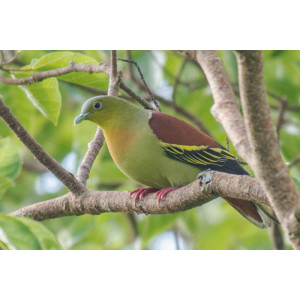Laughing Dove Did you see this animal?
Scientific Name : Spilopelia senegalensis
Family : Columbidae
Order : Columbiformes
Class : Aves
Phylum : Chordata
Other Name : Little Brown Dove
Habitat : Villages
Description : The Laughing Dove is a small warm brown dove (adult bird length approximately 27 cm, weight 80 g, wing 13 cm, bill 1.8 cm, tarsus 2 cm, tail 11 cm). It has a warm brownish- pink head, its neck and upper breast has a collar of black stipplings. It feeds on cereals, seeds of grasses and weeds. It breeds in January-October. The courtship display of the male includes pursuing the female, and bobbing and cooing around her. The laughing dove, a small long-tailed species, is commonly found in dry scrub and semi-desert habitats. They are often seen in pairs or small groups, with larger gatherings occasionally observed when drinking at waterholes in arid regions. Prior to approaching the water's edge, they assemble in trees near waterholes and are capable of drinking by sucking up water like other pigeons. Laughing doves primarily feed on fallen grass seeds, various plant matter, and small ground insects such as termites and beetles. They forage on the ground in grasslands and cultivated areas, displaying a quick and direct flight with regular wing beats and occasional wing flicks.
Their nests are constructed as very flimsy platforms of twigs, usually in low bushes, crevices, or even under the eaves of houses. Both parents contribute to nest-building, with males bringing twigs and females placing them. A pair typically lays two eggs within a day's interval, and both parents participate in incubating and feeding the young. Males tend to spend more time incubating during the day. Incubation begins after the second egg is laid, and the eggs hatch after about 13 to 15 days. Nesting adults may simulate injury to distract predators away from the nest. It is not uncommon for the same pair to raise multiple broods in the same nest, with records of up to seven broods observed in Turkey. Initially, the hatchlings are fed regurgitated crop-milk, a secretion from the lining of the parents' crop. The young fledge and leave the nest after approximately 14 to 16 days.
Their nests are constructed as very flimsy platforms of twigs, usually in low bushes, crevices, or even under the eaves of houses. Both parents contribute to nest-building, with males bringing twigs and females placing them. A pair typically lays two eggs within a day's interval, and both parents participate in incubating and feeding the young. Males tend to spend more time incubating during the day. Incubation begins after the second egg is laid, and the eggs hatch after about 13 to 15 days. Nesting adults may simulate injury to distract predators away from the nest. It is not uncommon for the same pair to raise multiple broods in the same nest, with records of up to seven broods observed in Turkey. Initially, the hatchlings are fed regurgitated crop-milk, a secretion from the lining of the parents' crop. The young fledge and leave the nest after approximately 14 to 16 days.
Distribution in Bangladesh
References:
description written by:Fatema-Tuz-Zohora,Department of Zoology, Jagannath University,Dhaka;information source: Encyclopedia of Flora and Fauna of Bangladesh, Vol-26, iucnredlist.org;taxonomic checklist:P. M. Thompson and S. U. Chowdhury (2020). A checklist of birds of Bangladesh.Birds Bangladesh;photo credit: bhekisisa(www.inaturalist.org/people/bhekisisa),photo shared from iNaturalist, photo copyright reserved according to iNaturalist rules;Derek Solomonmore information, please contact us.
description written by:Fatema-Tuz-Zohora,Department of Zoology, Jagannath University,Dhaka;information source: Encyclopedia of Flora and Fauna of Bangladesh, Vol-26, iucnredlist.org;taxonomic checklist:P. M. Thompson and S. U. Chowdhury (2020). A checklist of birds of Bangladesh.Birds Bangladesh;photo credit: bhekisisa(www.inaturalist.org/people/bhekisisa),photo shared from iNaturalist, photo copyright reserved according to iNaturalist rules;Derek Solomonmore information, please contact us.



















































































